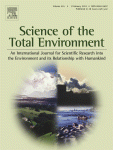Science of The Total Environment 435-436
Overview of articles on POPs in a new issue of the Science of The Total Environment journal.

Pages 326-336
Warren G. Foster, Anthony P. Cheung, Karelyn Davis, Gillian Graves, John Jarrell, Alain Leblanc, Chun Lei Liang, Tara Leech, Mark Walker, Jean Philippe Weber, Jay Van Oostdam
- Concentrations of metals and environmental contaminants were quantified in pregnant women from six Canadian Cities.
- Significant differences between cities were documented.
- Concentrations of several metals and contaminants were higher in foreign-born vs. Canadian women.
Pages 244-252
Tian Lin, Jun Li, Yue Xu, Xiang Liu, Chunling Luo, Hairong Cheng, Yingjun Chen, Gan Zhang
- OCPs were analyzed in air and water samples collected over marginal seas of China.
- α-HCH concentrations in the atmosphere were quite uniform.
- Atmosphericγ-HCH, TC, CC and DDT concentrations were highest in South China Sea.
- Dissolved OCP concentrations in water varied over a narrow range.
- Oceans exhibit net volatilization of some OCPs after a long period of prohibition.
Pages 7-13
J. Rivera-Austrui, K. Martínez, M.A. Adrados, M. Abalos, E. Abad
- A method for the analysis of PCDD/Fs and dl-PCBs in samples from long-term sampling systems is presented.
- Long-term sampling systems have proved to be suitable for the simultaneous sampling of PCDD/Fs and dl-PCBs.
- A criteria for the aliquot size to be used in analysis is set-up depending on sampling time and thermal process.
- The proposed methodology was tested on samples from incinerators and cement kilns.
Assessing PAH removal from clayey soil by means of electro-osmosis and electrodialysis
Pages 1-6
Ana T. Lima, Lisbeth M. Ottosen, Katja Heister, J.P. Gustav Loch
- PAHs are persistent and ubiquitous contaminants with difficult removal from clays.
- Electroremediation techniques (electro-osmosis and electrodialysis) may be a solution.
- Electrodialysis is used here for the first time to study the removal of PAH from soil.
- Removal efficiencies varied between 35 and 85%.
- Results show high discrepancies in PAH removal on spiked and field contaminated soils.
Integrated hybrid treatment for the remediation of 2,3,7,8-tetrachlorodibenzo-p-dioxin
Pages 563-566
Varima Bokare, Kumarasamy Murugesan, Jae-Hwan Kim, Eun-Ju Kim, Yoon-Seok Chang
- Facile synthesis of bimetallic Pd/nFe nanoparticles was carried out in the laboratory.
- 2,3,7,8-TeCDD was completely degraded at ambient conditions by Pd/nFe nanoparticles.
- DD was the sole end product obtained after reduction of 2,3,7,8-TeCDD by Pd/nFe.
- DD oxidation was achieved by sequential biodegradation usingSphingomonas wittichii.
9.9.2012




